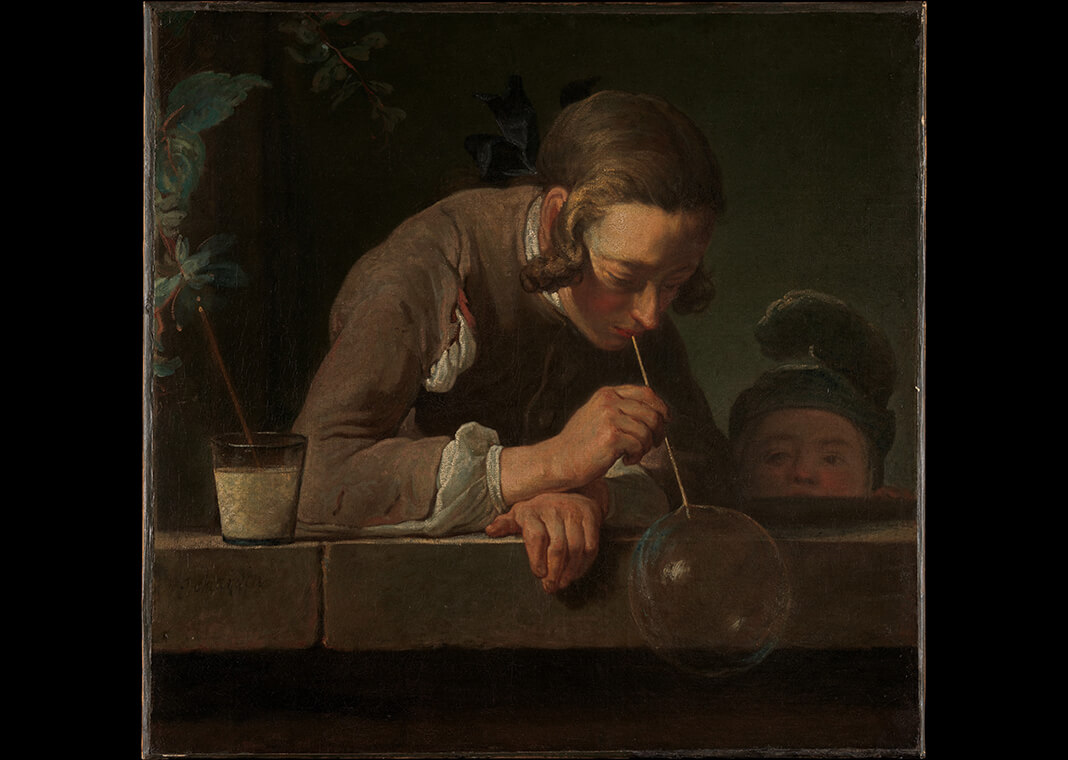
Editor’s note: Throughout July, we’re hosting 31 Days with St. Ignatius, a month-long celebration of Ignatian spirituality. In addition to the calendar of Ignatian articles found here, posts on dotMagis this month will explore the theme of “The Audacity of Ignatian Spirituality.”
I sense God’s presence strongly in the hallways and corridors of an art museum. Perhaps it is the silence of these halls that allows me to sense God close. Or perhaps it is the connection to the past that draws me into the panorama of time. I do think both these are true and yet, it is the beauty that lines the walls and sits upon pedestals that gives me a window into God’s goodness.
The artwork does not have to be religious in nature for it to be transcendent to me. Many works lend themselves easily to prayer as I find myself contemplating the reaction they evoke in me.
A quotidian painting like Jean Siméon Chardin’s Soap Bubbles is such an example. It is not a religious painting. It does not feature a cross or tell a story from Scripture. The 18th-century French painting depicts a young man creating bubbles out of a glass of soapy water and a straw, while a small child watches.
The painting is, indeed, beautifully rendered. It captures one singular moment, a second of time. The bubble is translucent and on the edge of bursting. I marvel at the stillness and concentration of the young man. There is something quiet and holy in it.
I find myself holding my breath when I look at this artwork. I find God’s presence in this ordinary moment, now captured in a precious work of art. I see the reflection of God’s Imago Dei, the image of God, both in the young man’s desire to create something beautiful, even if fleeting, in the bubble and then through the artist’s creation of capturing such a moment. We humans desire to create beauty, just like our Father in heaven.
The bubble itself is fleeting, just like our own brief existence here on earth. It reminds me of the Psalmist’s words:
Let me know how fleeting my life is.
You have made my days a few handbreadths,
and my lifetime is as nothing in your sight.
Surely everyone stands as a mere breath. (Psalm 39:4–5)
This lifetime will not last. The painting becomes a meditation on the early Christian practice of memento mori, Latin for “remember you will die.” This is not a lesson in morbidity but a reminder to live beautifully for this life will not last.
A small child watches quietly in the background of the painting. He does not disturb the moment, but as he watches, he learns the audacity of creating something beautiful that will not last forever, simply out of love.
Image: “Soap Bubbles” by Jean Siméon Chardin (Wentworth Fund, 1949), public domain via The Metropolitan Museum of Art.
Today in 31 Days with St. Ignatius, Rebecca Ruiz outlines Five Ways to Follow St. Ignatius’s Example to See All Things New in Christ. #31DayswithIgnatius

Thanks Shemaiah. Profound meaning in the art and in your creative text. Indeed life is beautiful.
Shemaiah thank you do much for this. I love Museums and Galleries but I have never thought of secular art in this way. I will from now on though and it will add another dimension to my prayer life.
It looks to me that the man in the painting is blowing the bubble over a balcony so that people below can enjoy it the beauty and fun as well.
I love your take Marian! Thank you! I enjoy the challenge of finding God in secular art. Makes me want to go to a museum SOON!
I feel truly blessed to be touched by these reflections. I love how gently the stories are told I love being invited into here and see and welcome each day is the gift each moment is a gift I love to draw. I love to colour. I love to play I love to pause. I love to listen. I love to watch. I love to see. I am very grateful to be alive each day is a gift amen.
Beautiful! Thank you!
Shemaiah – such a lovely thought for the day. I love museums as well and do sense God among all the art and people. Thank you for putting it into a wonderful Ignatian presence.
Thank you!